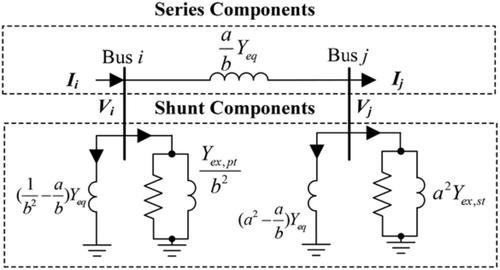当前位置:
X-MOL 学术
›
Int. Trans. Electr. Energy Syst.
›
论文详情
Our official English website, www.x-mol.net, welcomes your
feedback! (Note: you will need to create a separate account there.)
The modeling of tap‐changing transformers and P‐V buses using the sensitivity impedance matrix
International Transactions on Electrical Energy Systems ( IF 1.9 ) Pub Date : 2020-10-15 , DOI: 10.1002/2050-7038.12629 Insu Kim 1
International Transactions on Electrical Energy Systems ( IF 1.9 ) Pub Date : 2020-10-15 , DOI: 10.1002/2050-7038.12629 Insu Kim 1
Affiliation

|
Rapid deployment of distributed generation resources such as photovoltaic systems, wind farms, and other power electronics‐based loads has emphasized the requirement for tap‐changing transformers that minimize voltage variations and phase imbalances. Thus, various power‐flow algorithms able to model such a tap‐changing transformer have been proposed. The algorithms include a method that uses the bus impedance or admittance matrix. However, particularly the previous algorithms that use the impedance matrix did not take tap‐changing transformers and P‐V buses into account. Thus, this study models tap‐changing transformers for a power‐flow algorithm using the impedance matrix. For this purpose, it proposes a unified steady‐state T shaped transformer model with a tap changer on the primary or secondary side. The proposed power‐flow calculation algorithm also models P‐V buses by the sensitivity impedance matrix. Since the proposed method reduces the inversion of matrices, it can be faster than the Newton‐Raphson and fast decoupled methods (eg, the modified IEEE 30‐bus test system added by 3000 or more nodes), not losing the accuracy.
中文翻译:

使用灵敏度阻抗矩阵对分接变换变压器和P-V总线进行建模
快速部署分布式发电资源(例如光伏系统,风电场和其他基于电力电子的负载)已强调了对分接变换变压器的要求,以最大程度地减少电压变化和相位不平衡。因此,已经提出了能够对这种分接开关变压器建模的各种潮流算法。该算法包括使用总线阻抗或导纳矩阵的方法。但是,尤其是以前使用阻抗矩阵的算法并未考虑分接变换变压器和P-V总线。因此,本研究为使用阻抗矩阵的潮流算法对分接变换变压器建模。为此,它提出了一个统一的稳态T形变压器模型,在初级或次级侧带有一个分接开关。拟议的潮流计算算法还通过灵敏度阻抗矩阵对P-V总线建模。由于所提出的方法减少了矩阵的求逆,因此它可以比Newton-Raphson和快速解耦的方法(例如,经过修改的IEEE 30总线测试系统增加3000个或更多节点)更快,而不会丢失准确性。
更新日期:2020-12-07
中文翻译:

使用灵敏度阻抗矩阵对分接变换变压器和P-V总线进行建模
快速部署分布式发电资源(例如光伏系统,风电场和其他基于电力电子的负载)已强调了对分接变换变压器的要求,以最大程度地减少电压变化和相位不平衡。因此,已经提出了能够对这种分接开关变压器建模的各种潮流算法。该算法包括使用总线阻抗或导纳矩阵的方法。但是,尤其是以前使用阻抗矩阵的算法并未考虑分接变换变压器和P-V总线。因此,本研究为使用阻抗矩阵的潮流算法对分接变换变压器建模。为此,它提出了一个统一的稳态T形变压器模型,在初级或次级侧带有一个分接开关。拟议的潮流计算算法还通过灵敏度阻抗矩阵对P-V总线建模。由于所提出的方法减少了矩阵的求逆,因此它可以比Newton-Raphson和快速解耦的方法(例如,经过修改的IEEE 30总线测试系统增加3000个或更多节点)更快,而不会丢失准确性。










































 京公网安备 11010802027423号
京公网安备 11010802027423号